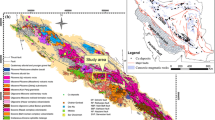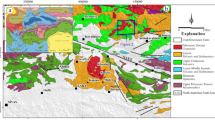Abstract
Rabor exploration area is in southeast of Kerman province, south of Urumieh-Dokhtar volcanic belt. Since there are many evidences of porphyry copper mineralization in this belt, prospecting and exploration of the intact and undiscovered places, especially the southern part of this belt, seems necessary. In this paper, use has been made of the “spectral feature fitting” (SFF) method to process ASTER satellite data (in Rabor exploratory area as a case study) for the identification and enhancement of hydrothermal alteration zones related to probable porphyry copper mineralization. The method is based on the comparison of absorption features in the image and the reference spectra. The distribution map of the indicator clay minerals, such as kaolinite, muscovite, illite, montmorillonite, alunite, pyrophyllite, dickite, chlorite, and epidote in Rabor exploratory area has been prepared with the help of this method. Identification and enhancement of alteration zones and overlaying Pay-Negin ore index on every individual zone reveal the capability and high efficiency of the SFF method in processing ASTER satellite data and preparing the distribution map of alteration minerals. Field and laboratory studies have shown that main alterations in this area are phyllic and argillic. These studies confirm the results obtained from remote sensing in the area.







Similar content being viewed by others
References
Aspinall RJ, Marcus AW, Boardman JW (2002) Considerations in collecting, processing and analyzing high spatial resolution hyperspectral data for environmental investigations. J Geogr Syst 4:15–29
Azizi H, Rsaouli AA, Babaei K (2007) Using swir bands from aster for discrimination of hydrothermal altered minerals in the northwest of Iran (Se-Sanandaj city); a key for exploration of copper and gold mineralization. Res J Appl Sci 6:763–768
Brown AJ, Walter MR, Cudahy TJ (2005) Hyperspectral imaging spectroscopy of a Mars analogue environment at the North Pole Dome, Pilbara Craton, Western Australia. Aust J Earth Sci 52:353–364
Chen X, Warner TA, Campagna DJ (2007) Integrating visible, near-infrared and short-wave infrared hyperspectral and multispectral thermal imagery for geological mapping at Cuprite, Nevada. Rem Sens Environ 110:344–356
Clark RN, Swayze GA, Gallagher AJ, King TVV, Calvin WM (1993) The U.S. geological survey, digital spectral library: Version 1: 0.2 to 3.0 microns. US Geological Survey Open File Report no. 93-592, 1340 p.
Crosta A, De Souza FC (2003) Targeting key alteration minerals in epithermal deposits in Patagonia, Argentina, using aster imagery and principal component analysis. Int J Rem Sens 24:4233–4240
Di Tommaso I, Rubinstein N (2007) Hydrothermal alteration mapping using aster data in the Infiernillo porphyry deposit, Argentina. Ore Geol Rev 32:275–290
Harris AT (2006) Spectral mapping tools from the Earth Sciences applied to spectral microscopy data. Cytometry A 69:872–879
Masoomi F (2007) Preparation of mineral potential map of northern Baft by using GIS, M.Sc thesis, Shahid Bahonar University of Kerman
Rajesh HM (2004) Application of remote sensing and GIS in mineral resource mapping-An overview. J Miner Petrol Sci 99:83–103
Sabine C (1999) Remote sensing strategies for mineral exploration. In: Rencez A (ed) Remote sensing for the earth sciences—manual of remote sensing. American Society of Photogrammetry and Remote Sensing, pp. 375–447
Sabins FF (1999) Remote sensing for mineral exploration. Ore Geol Rev 14:157–183
Srdic A, Dimitrijevic MN, Cvetic S, Dimitrijevic MD (1972) Geological map of Baft,1:100000 SERIES SHEET 7348, Geological survey of Iran.
Van Der Meer FD (2004) Analysis of spectral absorption features in hyperspectral imagery. Int J Appl Earth Obs Geo Inf 5:55–68
Verdel CS, Knepper D, Livo KE, McLemore VT, Penn B, Keller R (2001) Mapping minerals at the copper flat porphyry, New Mexico, using AVIRIS data, Proceedings of the Tenth JPL Airborne Earth Science Workshop, 427–433.
Author information
Authors and Affiliations
Corresponding author
Rights and permissions
About this article
Cite this article
Abbaszadeh, M., Hezarkhani, A. Enhancement of hydrothermal alteration zones using the spectral feature fitting method in Rabor area, Kerman, Iran. Arab J Geosci 6, 1957–1964 (2013). https://doi.org/10.1007/s12517-011-0495-0
Received:
Accepted:
Published:
Issue Date:
DOI: https://doi.org/10.1007/s12517-011-0495-0




